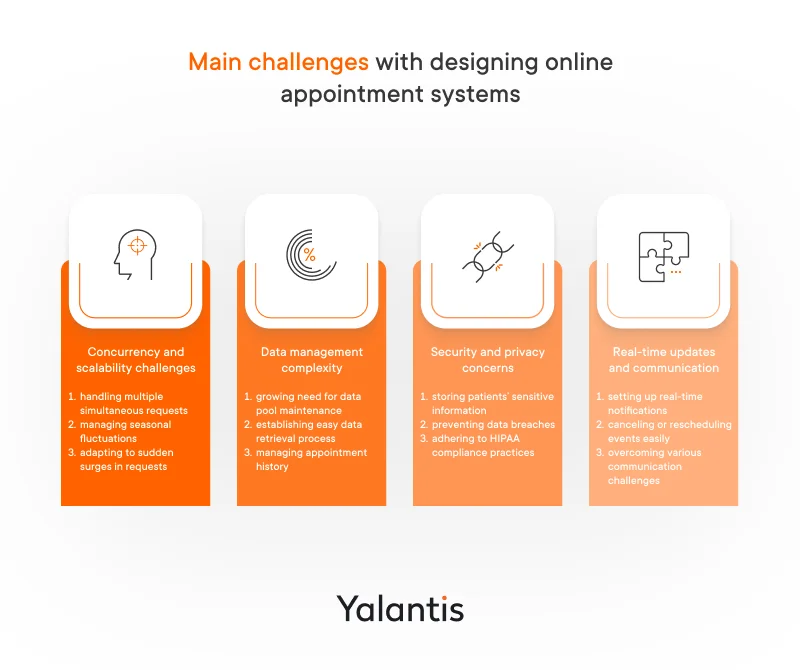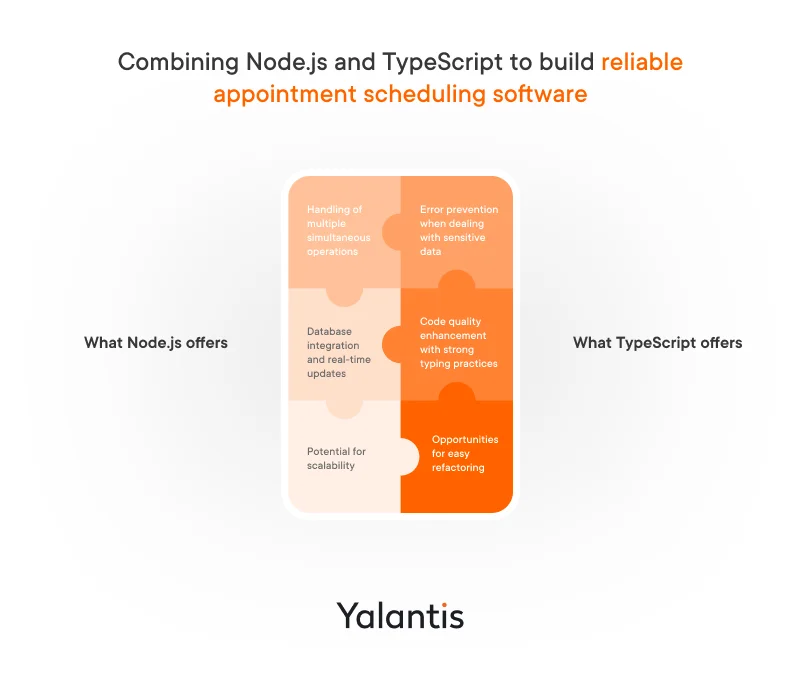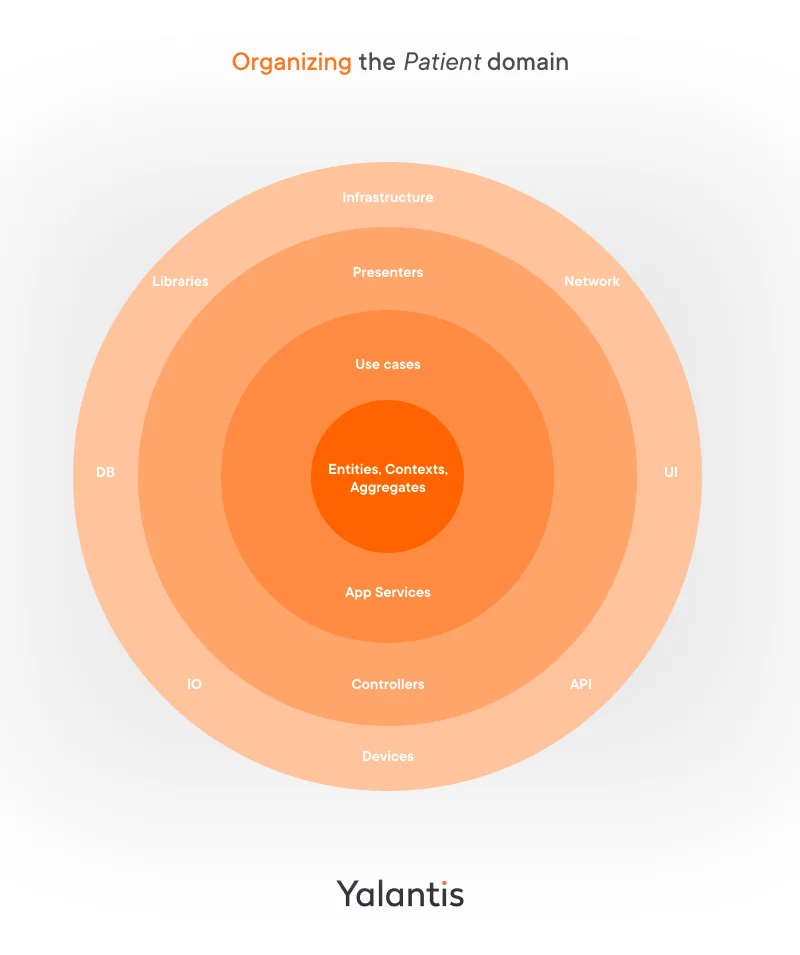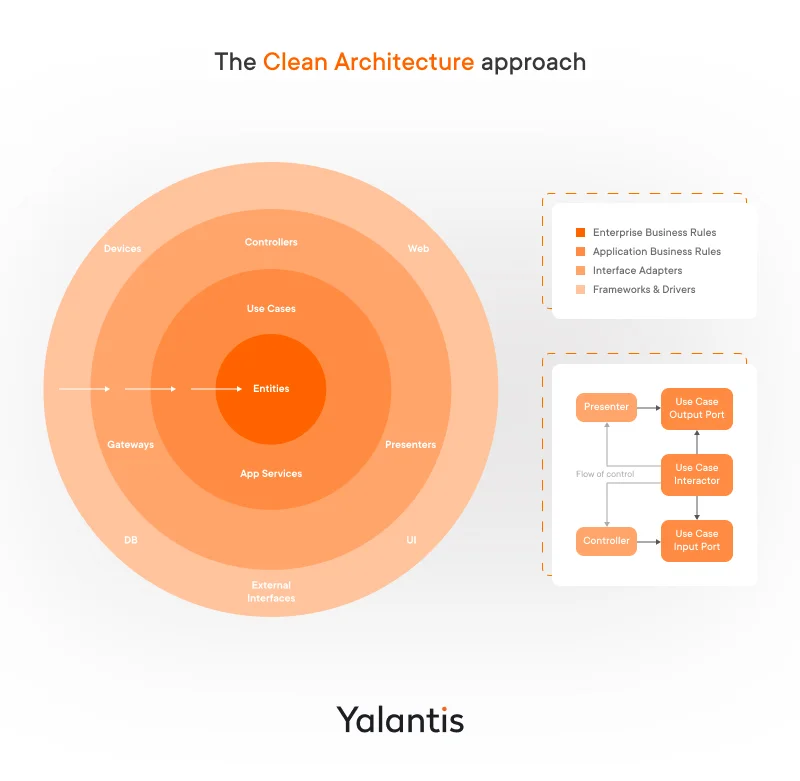
An extensive guide to building a patient-centered and scalable appointment scheduling system with Node.js
Summarize:
Back in 2021, 25% of patients preferred to use online booking for medical services according to a GetApp survey of 200 US consumers, and nearly 70% of respondents stated that they’d choose an online booking option if it were available. Today, most consumers prefer making appointments online because they can easily synchronize their visit with their personal calendar or reschedule an appointment if needed.
This is why healthcare providers should adopt software for scheduling appointments online. But how can you do that? Implementing such software is both a challenge and an opportunity to significantly improve patient satisfaction.
In this article, we explore the process of developing advanced online appointment software using Node.js, TypeScript, and other tools that enhance their capabilities. You will learn about features that make these tools a great option for building appointment systems while accounting for the complexity of the healthcare industry.
What is an appointment scheduling system?
What is an appointment scheduling system?

Appointment scheduling system dashboard view
An appointment scheduling system is a virtual environment designed for automating routine processes in healthcare facilities. It allows patients to book appointments, clinicians to manage their schedules, and administrators to manage the entire system and ensure a consistent workflow.
There’s no universal approach to creating an appointment scheduling system, since every hospital or clinic has specific demands. However, there are a few processes that any online appointment system should be able to handle:
- Storing large data arrays and efficiently working with them
- Handling multiple simultaneous booking, rescheduling, and cancelation processes
- Ensuring data security
- Offering scalability
- Having a user-friendly interface for both doctors and patients
- Integrating with external services for payments, medication orders, etc.
Patient care and support consists of dozens of processes including examinations, treatments, medical prescribing, and follow-up appointments. An appointment scheduling system integrated within a facility’s internal environment brings the following benefits:
- Quicker appointment scheduling. The system enhances the efficiency of hospital staff in scheduling appointments, reducing wait times for patients and streamlining the path from initial examination to follow-up visits.
- Improved access to electronic health records (EHRs). With an integrated EHR system, doctors gain immediate access to a patient’s medical history. This aids in making more informed decisions during examinations, leading to better patient outcomes and more efficient treatment plans.
- Enhanced cross-institutional integration. The system’s ability to integrate seamlessly with external medical institutions allows for easy retrieval of a patient’s medical history from other facilities. This ensures continuity of care, comprehensive treatment planning, and efficient remote patient monitoring, reducing the risk of medical errors and improving overall healthcare quality.
- Streamlined medication ordering and delivery. Thanks to this feature, the system facilitates efficient collaboration with external pharmacy services. This ensures timely and accurate delivery of medications to patients, enhancing the effectiveness of treatment regimes.
- Enhanced patient engagement. Through user-friendly interfaces and digital communication channels, patients can actively participate in appointment scheduling, access their own EHRs, and receive medication updates. Increased engagement fosters a sense of ownership in their health among patients, leading to improved adherence to treatment plans and better overall health outcomes.
Below, we explore the main challenges you can encounter when developing an appointment scheduling system and ways of dealing with them.
Need to enable booking functionality for your facility’s website?
Here’s how we can help
Get expert tipsMain challenges with designing online appointment systems

Even though most appointment scheduling systems look like a digital calendar with some extra features, the process of developing them is complex. Let’s discuss the main challenges that arise during development and integration of appointment scheduling systems and learn how we can address them.
#1 Concurrency and scalability challenges
According to a US Census Bureau report, one in five Americans will be 65 or older by 2030. This will be reflected in the number of people seeking medical care, and managing the influx efficiently will be demanding.
Appointment scheduling systems must handle a multitude of requests simultaneously:
- Patients seeking appointments
- Doctors updating their availability
- Administrators managing schedules
This complexity is similar to the challenges faced in IoT platforms, where asynchronous operations are prevalent. For insights into enhancing user experience in such environments, explore our article on improving UX in IoT platforms.
Aside from that, the healthcare industry experiences periodic fluctuations in patient demand due to events like seasonal infections or the recent COVID-19 pandemic. Scalability is vital to accommodate sudden surges in appointment requests while maintaining optimal performance. A well-designed system scales seamlessly, ensuring that patients receive timely care even during peak periods.
#2 Data management complexity
The healthcare sector generates approximately 30% of the world’s data, making it the largest contributor to the global data pool. From fax and paper records to vitals retrieved from wearable devices, the number of patient records is growing exponentially, and software vendors must offer solutions to efficiently manage it.
Every patient’s unique information must be stored securely and accurately. Errors or data breaches can have serious consequences, decreasing patient trust and raising issues with legal compliance.
Moreover, maintaining a comprehensive appointment history is essential for both patients and healthcare providers. A scheduling system should offer a transparent history of appointments for each patient and ensure that follow-ups are available when needed.
#3 Security and privacy concerns
In May 2023, a ransomware attack on Perry Jonhson & Associates, a transcription services provider to the medical sector, resulted in almost 9 million patient records being partially or completely disclosed. The number and frequency of large breaches indicate that healthcare providers are struggling with establishing proper security measures to protect their patients.
In the United States, the Health Insurance Portability and Accountability Act (HIPAA) mandates strict rules for handling healthcare data. Any scheduling system dealing with such data must comply with these rules to avoid legal repercussions.
Data must be encrypted during transmission and storage to prevent unauthorized access, and robust access control mechanisms are necessary to restrict access to authorized personnel only.
#4 Real-time updates and communication
The modern patient communicates with healthcare providers on multiple occasions in order to:
- change an appointment time
- find out a doctor’s availability
- cancel or reschedule visits
Any delays or inaccuracies during these processes can lead to patient dissatisfaction and disrupt the healthcare provider–patient relationship.
The scheduling system must support various communication channels, including email, SMS, and in-app notifications, to cater to patients’ preferences and ensure patients stay informed.
See how Yalantis addressed these challenges by developing a SaaS product for a German healthcare company
View case studyCore features of an appointment scheduling system
The goal of an appointment scheduling system is to efficiently manage patient appointments. Its core functionality includes:
- Real-time updates. Your system should provide instant notifications and updates, ensuring that appointment changes are communicated promptly.
- Role and permission management. By defining and assigning specific access levels to different user types, such as administrators, doctors, and patients, the system controls who can view, modify, or manage appointments and sensitive data, maintaining system integrity and compliance with privacy standards.
- Conflict resolution. Implementing a robust conflict resolution workflow helps avoid double bookings and ensures a smooth scheduling process.
- Notifications. Automated notifications for patients and doctors, such as appointment reminders and confirmations, enhance the patient experience and reduce no-show rates.
- Calendar synchronization. By integrating your appointment scheduling system with your personal calendar, you’ll never miss an important visit and can reschedule in a few clicks.
- Administrative tools. Functionality for managing appointments, rescheduling, and handling exceptions is essential for healthcare staff to maintain business continuity.
You can increase the efficiency of an online appointment system even further by creating a user-friendly interface that’s convenient for both patients and doctors. Aside from that, a user-friendly UI provides clinicians with a clear picture of a patient’s health and helps them build a comprehensive treatment strategy.
Here are some features that will help in achieving that:
- Facility and doctor listings. Displaying facilities and doctors with advanced filtering and search capabilities simplifies the process of finding the right healthcare provider.
- Patient medical histories. Providing access to patients’ medical histories empowers doctors to make informed decisions about patient care.
- Patient search. An intuitive patient search feature allows healthcare providers to quickly find patient records, streamlining appointment scheduling.
- Notifications dashboard. A centralized notifications dashboard for patients and doctors ensures that important updates and reminders are easily accessible.
In the next section, we explore why Node.js and TypeScript is the optimal combination for crafting robust and efficient scheduling systems.
Meanwhile, check out our detailed roadmap that allows us to build comprehensive healthcare software!
Learn moreWhy are Node.js and TypeScript the best choice for building an appointment scheduling system?

Healthcare is a complicated system, and adding new technology to the global environment requires a thoughtful choice of tools. By using Node.js and TypeScript as your starting kit, you can build a resilient and flexible system that allows for easy scalability.
Now, let’s take a look at how each of these technologies can be useful in your software development process.
Harnessing the asynchronous power of Node.js to increase the speed of operation processing
Node.js is often a go-to platform for building scalable network applications. It is built on the foundation of an event-driven, non-blocking I/O model and tailor-made for handling asynchronous operations, such as:
- Concurrency. A lot of operations within the appointment scheduling system happen simultaneously: patients pick time slots, doctors update their availability, administrators manage the whole system. Node.js excels at managing this concurrency by executing tasks in parallel without blocking the main thread.
- Real-time updates. Node.js facilitates seamless real-time communication through technologies like WebSockets, enabling instant notifications and keeping patients informed.
- Scalability. Healthcare operations experience fluctuating demand, with peak periods and quieter times. The scalability of Node.js ensures that the system can easily handle increased loads during busy hours while remaining responsive during quieter periods.
In addition, Node.js features a diverse set of libraries, modules, and tools, which can be used to offer multiple solutions for common challenges:
- Database integration. Node.js seamlessly integrates with various databases, both SQL and NoSQL. This flexibility allows healthcare providers to choose the database system that best suits their data management needs.
- Real-time frameworks. Node.js facilitates seamless real-time communication through technologies like WebSockets, enabling instant notifications and keeping patients informed.
- Testing frameworks. Node.js offers a plethora of testing frameworks and libraries, making it easier to implement robust testing practices, including unit, integration, and end-to-end tests.
- PDF generation. For generating appointment-related documents, numerous Node.js libraries, such as PDFKit and Puppeteer, simplify the process of creating PDF documents.
Now, let’s switch to TypeScript and examine its features that can help you achieve great results in scheduling software development when combined with Node.js.
TypeScript’s strong typing for healthcare data management
TypeScript is considered a strongly typed programming language. When it comes to healthcare data, this feature brings many advantages:
- Error prevention. TypeScript’s strong typing system catches errors during development, preventing common issues such as data type mismatches and null reference errors. This level of error prevention is crucial when dealing with patient information and schedules.
- Code quality. Strong typing enhances code quality by making code more self-documenting. Developers can easily understand the types of data being handled, reducing ambiguity and making the codebase easier to maintain.
- Refactoring and scalability. TypeScript’s type safety provides confidence when making changes to the codebase, minimizing data-related issues during healthcare system evolution and extension.
The synergy between Node.js and TypeScript helps create a powerful, efficient, and robust healthcare appointment scheduling system. In the coming sections, we navigate the technical intricacies of implementing this system, ensuring that healthcare providers can deliver the highest quality of patient care.
How to efficiently approach the architecture and design of appointment scheduling systems
A well-thought-out system architecture streamlines scheduling and contributes to the overall effectiveness of healthcare services. It can enhance the patient experience, optimize resource allocation, and provide a foundation for scalability.
Let’s consider examples of two popular architectures that could assist us in building a robust system.
Domain-driven design (DDD): Organizing the heart of a healthcare system
Domain-driven design (DDD) uses analytics and evidence to make decisions and validate design choices. DDD promotes a clear understanding of the domain, ensuring that system models are based on real-time healthcare scenarios and user interactions.

Here’s how you can outline the main architectural components of the scheduling system:
- Patient entity. The patient is a central entity, representing individuals seeking medical care. Attributes like name, contact information, and medical history are encapsulated within this entity.
- Value objects. Medical history and contact details can be represented as value objects. Value objects are immutable and add granularity to our domain.
- Aggregates. An appointment can be seen as an aggregate root that encapsulates a patient’s appointments. This ensures that appointments are managed consistently and adhere to business rules.
- Repositories. Repositories allow us to interact with our entities. A patient repository can handle operations related to patients, such as data retrieval, data creation, and data updates.
- Services. DDD also emphasizes the role of services. For example, a patient service can handle complex operations like scheduling appointments, ensuring that business logic is encapsulated appropriately.
This is a basic example illustrating how you can organize your online appointment service. However, you can enhance system reliability by combining multiple architectural approaches. One of the great options for that is clean architecture; let’s delve into how it works for healthcare solutions.
Clean architecture: A blueprint for maintainability

Clean architecture provides a clear blueprint for structuring your application, separating concerns, and enhancing maintainability. It consists of several layers:
- Entities. At the core of Clean Architecture are entities, representing fundamental data structures. In a scheduling system, we have entities like patient, doctor, and facility.
- Use cases. Use cases represent the application’s business logic. Examples include schedule an appointment, update patient information, and generate a medical report. These use cases are independent of external frameworks and libraries.
- Interface adapters. This layer acts as a bridge between use cases and external systems or frameworks. It includes implementation of interfaces needed to communicate with external components, such as databases or user interfaces.
- Frameworks and drivers. The outermost layer deals with external elements like web frameworks, databases, and user interfaces. It is responsible for handling the technicalities of these components while keeping core business logic independent and testable.
Now, let’s take a look at some use cases for appointment scheduling systems and how clean architecture helps structure them:
Use case #1: Schedule an appointment
- Entities: Patient and doctor entities represent participants in the appointment.
- Logic: The schedule appointment use case contains scheduling logic.
- Interface adapters: This layer handles interactions with the user interface, database, and notification systems.
- Frameworks and drivers: The web interface or mobile app communicates with the system through this layer.
Use case #2: Generate a medical report
- Entities: Medical records and patient information are core entities.
- Logic: This use case encapsulates report generation logic.
- Interface adapters: This layer interfaces with the PDF generation library and data storage.
- Frameworks and drivers: The PDF generation module and database are managed at this layer.
Clean architecture ensures that your healthcare scheduling system remains modular and adaptable. It promotes code that is easily testable and maintainable, facilitating future enhancements and changes.
Learn how the right data storage solution can enhance your appointment scheduling system functionality. Receive a guide with code examples and tips from our experts to your email
Send me the guideEnsuring quality control: Testing various behavior cases for an appointment scheduling system
When building software as complex as an appointment scheduling system, you need to ensure that every component works properly. To achieve this, the technology team conducts numerous tests and generates reports with various cases of system behavior. However, the very first step involves developers writing tests for the system themselves.
There are several types of testing supported by Node.js:
Unit testing:
- Example library: Jest
- Description: Unit testing focuses on testing individual components or functions in isolation to ensure they work as expected. Jest is a popular testing library for Node.js that provides a simple and powerful framework for writing unit tests.
Integration testing:
- Example library: Jest
- Description: Integration testing verifies interactions between different components or systems.
End-to-end (E2E) testing:
- Example library: Puppeteer (for browser automation)
- Description: E2E testing ensures that the entire application works seamlessly from the user’s perspective. Puppeteer is a headless browser automation library that allows you to simulate user interactions and test the application’s functionality.
Behavior-driven development (BDD):
- Example library: Cucumber
- Description: BDD emphasizes collaboration between developers, testers, and non-technical stakeholders. Cucumber enables you to write feature files in a natural language format, making tests readable and accessible to non-developers.
Facilitate document generation with streams in Node.js
Document generation is a common process during appointment scheduling. Generally, documents include appointment confirmations, payment invoices, prescriptions, and treatment protocols. The format of choice for patients’ documentation is usually PDF, because it’s reliable and readable on most devices.
Node.js, with its emphasis on asynchronous and non-blocking I/O operations, is particularly well-suited for tasks like PDF generation. But what sets it apart is its adeptness at handling streams.
Streams are a way of reading data from or writing data to a source. They are essentially a sequence of data made available over time. Streams can be read from or written to asynchronously, which means that you can process data in chunks rather than loading everything into memory at once.
When generating PDFs, streams become invaluable in a few ways:
- Efficient resource use. Streams allow you to process and write data in chunks, reducing memory use. This is especially important when dealing with large datasets or generating multiple PDFs simultaneously.
- Real-time generation. Streams enable you to generate and deliver PDFs to users as they are being created, providing instant access to documents.
- Integration with data sources. Streams can seamlessly integrate with various data sources, whether you’re pulling data from a database, an API, or user input. This flexibility is essential in healthcare scheduling systems.
PDF generation libraries in Node.js
Node.js features a range of libraries and modules for generating PDF documents. Some popular options include:
- PDFKit. This popular library allows you to create PDF documents in a stream-like fashion. You can add text, shapes, images, and more to your PDF documents and then stream them directly to a file, the network, or an HTTP response.
- Puppeteer. While primarily known for its headless browser capabilities, Puppeteer can be used to generate PDFs from HTML content. It leverages the DevTools Protocol and provides options for streaming PDFs to different destinations.
Let’s create a simple example for generating a medical prescription using Node.js and PDFKit:
const fs = require('fs'); const PDFDocument = require('pdfkit'); // Create a new PDF document const doc = new PDFDocument(); // Create a write stream to save the PDF const writeStream = fs.createWriteStream('prescription.pdf'); // Pipe the stream to the PDF document doc.pipe(writeStream); // Add content to the document doc.fontSize(14).text('Prescription', { align: 'center' }); doc.moveDown(); doc.fontSize(12).text('Patient Name: John Doe'); doc.text('Date: ' + new Date().toLocaleDateString()); doc.moveDown(); doc.fontSize(10).text('Prescribed Medications:'); doc.moveDown(); // Add prescription details doc.text('- Medication 1: 1 tablet daily'); doc.text('- Medication 2: 2 tablets twice a day'); doc.moveDown(); // Add additional information or comments doc.fontSize(10).text('Additional Comments:', { underline: true }); doc.moveDown(); doc.text('Patient should take the medications with meals.'); doc.text('Follow up with the doctor in two weeks.'); doc.moveDown(); // End the PDF creation doc.end(); // Notify when writing to the file is finished writeStream.on('finish', () => { console.log('Prescription successfully created.'); }); // Handle errors during file writing writeStream.on('error', (err) => { console.error('Error creating prescription:', err); });
Conclusion
Appointment scheduling systems are a crucial component of the modern healthcare industry. They increase the efficiency of healthcare facilities by streamlining the appointment booking process, facilitating better patient engagement, and improving cross-institutional collaborations.
Challenges in creating such systems include dealing with the ever-increasing volume of healthcare data, ensuring scalability to accommodate patient demands, and safeguarding sensitive patient information. Addressing these challenges is critical for the success of any healthcare software.
Thankfully, you can achieve success by selecting a proven technology stack, such as Node.js enhanced with TypeScript and ORM databases. These tools can help you build a clean and scalable software architecture that can deal with multiple asynchronous requests and easily integrate into your current software environment.
Looking for tailored and HIPAA-compliant appointment scheduling software?
Build your perfect solution with Yalantis
Contact usHow can Yalantis help you build reliable appointment scheduling software?
By now, you’re aware of the essential steps that are required to develop an appointment scheduling system. You’re also aware that they can take a lot of time and resources. As a software vendor with expertise in creating digital solutions for the healthcare industry, Yalantis can help you simplify this process. Here’s what we offer:
- Expertise in scheduling systems. Yalantis brings substantial experience in developing scheduling systems, showcasing a deep understanding of the intricacies involved.
- Tailored solutions. We pride ourselves on providing customized scheduling solutions, recognizing that each client’s requirements are unique. Our team is adept at tailoring systems to specific business processes.
- Cutting-edge technologies. Staying at the forefront of technological advancements, we leverage cutting-edge tools and frameworks to build robust and scalable scheduling systems.
- Dedicated support and maintenance. Beyond development, we offer dedicated support and maintenance services, ensuring that your scheduling system operates smoothly and efficiently over the long term.
- Client-centric approach. Our client-centric approach involves close collaboration to understand your business objectives, enabling us to create scheduling systems that align seamlessly with your organizational goals.
- Timely delivery. We are committed to delivering projects within agreed timelines, emphasizing efficiency without compromising the quality of our solutions.
Discover the benefits of working with Yalantis to build secure and scalable healthcare solutions
Explore our industry expertiseFAQ
What is an appointment scheduling system?
An appointment scheduling system is a digital platform designed to automate the process of booking, managing, and organizing appointments, particularly in healthcare facilities, allowing patients to schedule visits, clinicians to manage their schedules, and administrators to maintain an efficient workflow.
How does Node.js contribute to the security of an appointment scheduling system?
Node.js enables efficient handling of asynchronous requests and data encryption, which are essential for HIPAA compliance and protecting sensitive patient information.
How does Node.js address the complexities of data management and real-time updates in an appointment scheduling system?
Node.js, when combined with technologies like TypeScript and TypeORM, creates an event-driven architecture that allows for efficient handling of multiple concurrent tasks and seamless communication between components.
Rate this article
4.8/5.0
based on 46 reviews







